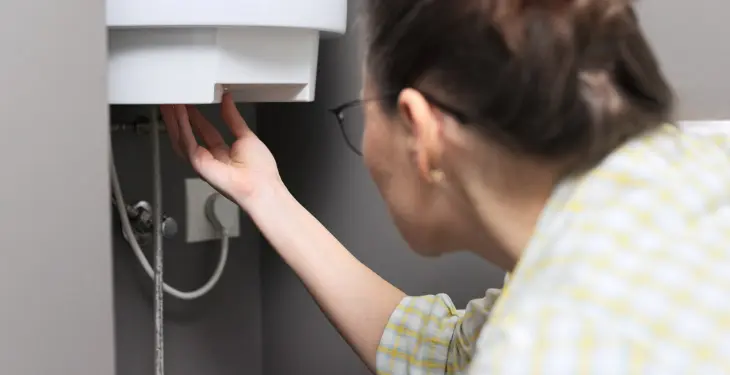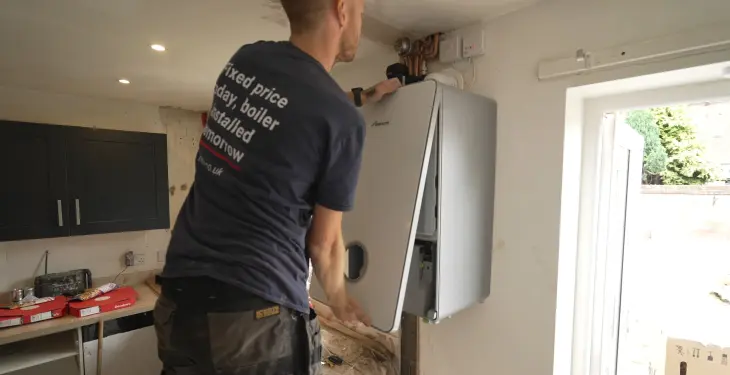

Written by Stephen Day
Gas Safe Engineer
Updated: 27th November, 2025
Find out why your boiler has no power and the key checks you can safely do before calling an engineer.
Get a new boiler quote, save up to £550 per year (0% APR available).
If your boiler has suddenly turned off and shows no sign of life, the cause is usually electrical.
Power loss often comes from a blown fuse, a tripped RCD switch, a fault inside the boiler or an issue with the home’s electricity supply.
Some checks are safe to do yourself, but internal faults must be handled by a Gas Safe engineer.
Start with the boiler’s electrical connection. If the home has had a brief outage or surge, the boiler may have lost power.
A quick look at the fuse box can tell you if the circuit feeding the boiler has tripped.
If you find a switch in the off position, reset it once.
If it trips again, avoid repeated resets as this suggests a fault.
Homes with pay as you go meters should also check for low credit.
Loose cables can interrupt power too. Make sure the spur switch and plug connections are secure.
Most boilers are powered through a fused spur on the wall.
If this fuse blows, the boiler will appear dead.
A fuse can blow after a surge or simply due to age. Replacing it with the same rating may restore power.
If the new fuse also blows, do not keep replacing it.
This points to an internal fault inside the boiler that needs a Gas Safe engineer.
Your fuse box may have an RCD that cuts power if it senses a fault. If the RCD has tripped, reset it once.
If it trips again, stop there. Repeated tripping means there is an electrical issue that must be checked by a professional.
Boilers contain small internal fuses that protect their electronics.
These can fail after surges, moisture entry or general wear.
Only a Gas Safe engineer should open the boiler casing to check or replace these fuses.
A faulty PCB (Printed Circuit Board) can also cause complete power loss. This is the main control unit inside the boiler.
Typical signs include:
No display on the front panel
Boiler switching off randomly
Fuses blowing without clear cause
PCB faults must be diagnosed and replaced by a qualified engineer.
Sometimes the boiler is actually running, but the display panel or LED light has failed.
If the heating still works but the screen is blank, the display may be faulty rather than the boiler itself.
A professional can test this safely.
These simple checks are safe for most homeowners:
Check the fuse box for tripped switches
Check the fused spur on the wall
Replace thermostat batteries if they are wireless
Check credit on a pay as you go meter
Secure any loose cables
Press the boiler’s reset button once
If the boiler still shows no signs of power, the fault is likely internal.
A professional is needed if:
Fuses keep blowing
The RCD continues to trip
The PCB may be faulty
The boiler has no display even with confirmed power
You notice burning smells, clicking or unusual noises
Resetting the boiler does not help
It is illegal and unsafe for anyone who is not Gas Safe registered to remove the boiler casing or work on gas components.
Once the fault is found, the engineer may advise whether repair or replacement is the best option.
A repair is usually suitable when the boiler is under ten years old and the part is simple to replace.
A replacement is usually recommended when the boiler is older, breaks down often, or requires costly electrical parts that are becoming obsolete.
If your boiler still will not turn on after checking the fuse box, thermostat, power supply and basic controls, the issue is likely inside the boiler.
Internal faults, wiring problems, PCBs and blown internal fuses should only be handled by a Gas Safe registered engineer.
A qualified engineer can run full safety checks, find the exact cause of the power loss and carry out the right repair.
This keeps your home safe and ensures your heating and hot water are restored correctly.
Last updated: 27th November, 2025

Written by Stephen Day
Gas Safe Engineer at iHeat
Stephen Day is a Gas Safe registered and FGAS certified engineer with over 20 years of hands-on experience in the heating, cooling, and renewable energy industry, specialising in boiler installations, air conditioning, and heat pump systems.
LinkedInArticles by Stephen Day are reviewed by iHeat’s technical team to ensure accuracy and reliability.

22nd December, 2025
Based on data from over 7000 boiler installations completed by iHeat in the past 12 months...
 Read Article
Read Article

22nd December, 2025
Here’s a quick roundup of the best combi boilers for 2026.
 Read Article
Read Article

22nd December, 2025
When your old boiler breaks down and it comes time to replace it with a new one, it might...
 Read Article
Read Article
No obligation. Takes less than 60 seconds.